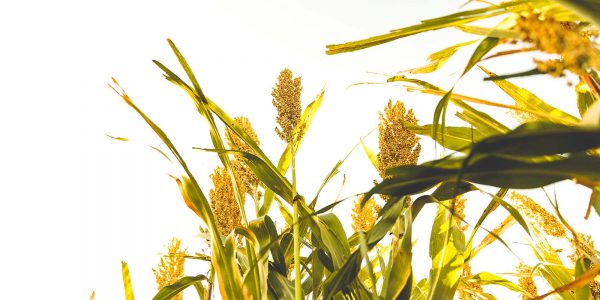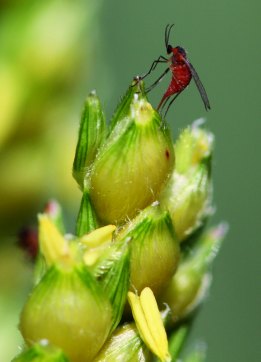
Sorghum Midge
The Silent Predator

Sorghum midge adults are tiny, fragile-looking, reddish orange flies about 1/8 to 1/16 inches long, smaller than a fruit fly. Each midge has the ability to lay 50 eggs and does a remarkable job of spreading them around to 50 different sorghum flowers (florets) during her one-day lifespan. These eggs hatch in 2-3 days with larvae developing between the spikelet glumes and feeding commences on the developing kernel. Larvae develop over a 9-11 day period after which they pupate between the glumes for three days. This is a life cycle of 15 days under optimum conditions. The emerging adult fly leaves behind the clear or white pupal skin. When one sees these cocoon-like remains at the tip of the spikelet, damage has already been done, resulting in no or shriveled grain.
How Serious is Sorghum Midge?
Assuming a large sorghum head has 2,500 flowers that bloom over a 7-9 day period, 50 adult midge could effectively destroy the whole panicle or grain head. Remember, not all fields bloom uniformly, which means late blooming heads can be damaged by the next cycle or midge hatch.
Monitoring Sorghum Midge
To know the presence and possible population in one’s sorghum field requires appropriate inspection. Since sorghum heads flower from top down, field checks must be made beginning shortly after blooming begins. Inspect field borders first, particularly those downwind of earlier flowering sorghum or johnsongrass, a likely intermediate host. It is best to monitor for the insect from mid-morning to early afternoon and preferably at a quiet or low wind time, as the fragile insect may be less active during windy periods. In any given sorghum head the number of missing kernels can vary considerably, depending on the damage caused by the midge.
Controlling Sorghum Midge
Chemical control depends on not only the insect population, i.e. insects per head, but also on the cost of chemical per application, the crop value and plant population. Currently, one midge per head suggests value for spraying for the insect. When most sorghum is planted at a normal time and over a narrow time frame so that flowering is pretty well at the same time, the likelihood of a midge problem is greatly reduced. Later season planted sorghum is generally more vulnerable. Insecticide residues should effectively suppress midge egg laying 1-2 days after treatment. If adults are found 3-5 days after the first application of insecticide, immediately apply a second insecticide treatment. Obviously, more uniform fields will require less treatment. Choice of insecticides can best be determined by your agricultural supplier or aerial applicator, which may be determined by success of specific compound or cost. Sorghum midge control suggestions include: Chlorpyrifos (Lorsban 4E)* Malathion (Fyanon ULV)* Cyfluthrin (Bathroid 2E)* Methomyl (Lannate)* Cythalothrin (Karate 1E and Warrior 1E)** Zeta-cypermthrin (Mustang Max)* Esfenvalerate (Asana XL)* *restrictions on days from last application to harvest or graze **do not graze livestock in treated area or harvest for fodder, silage or hay. Many entomologists place a clear plastic bag over randomly selected panicles and lightly shake the head. The midge can then be counted in the plastic bag.
Pest Management in Blooming Sorghum – Texas A&M AgriLife Extension

